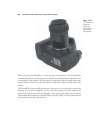hot shoe A mount on top of a camera used to hold an electronic flash, while provid-
ing an electrical connection between the flash and the camera. Also called an accessory
shoe.
hyperfocal distance A point of focus where everything from half that distance to infin-
ity appears to be acceptably sharp. For example, if your lens has a hyperfocal distance
of four feet, everything from two feet to infinity would be sharp. The hyperfocal dis-
tance varies by the lens and the aperture in use. If you know you’ll be making a grab
shot without warning, sometimes it is useful to turn off your camera’s automatic focus,
and set the lens to infinity, or, better yet, the hyperfocal distance. Then, you can snap
off a quick picture without having to wait for the lag that occurs with most digital cam-
eras as their autofocus locks in.
image rotation A feature that senses whether a picture was taken in horizontal or ver-
tical orientation. That information is embedded in the picture file so that the camera
and compatible software applications can automatically display the image in the cor-
rect orientation.
image stabilization A technology that compensates for camera shake, usually by
adjusting the position of the camera sensor or (with the implementation used by
Nikon) by re-arranging the position of certain lens elements in response to movements
of the camera.
incident light Light falling on a surface.
International Organization for Standardization (ISO) A governing body that pro-
vides standards used to represent film speed, or the equivalent sensitivity of a digital
camera’s sensor. Digital camera sensitivity is expressed in ISO settings.
interpolation A technique digital cameras, scanners, and image editors use to create
new pixels required whenever you resize or change the resolution of an image based on
the values of surrounding pixels. Devices such as scanners and digital cameras can also
use interpolation to create pixels in addition to those actually captured, thereby increas-
ing the apparent resolution or color information in an image.
ISO See International Organization for Standardization (ISO).
i-TTL Nikon’s intelligent Through-The-Lens flash metering system, which uses pre-
flashes to calculate exposure and to communicate between flash units, using the cam-
era’s 2,016-segment RGB sensor viewfinder exposure meter.
jaggies Staircasing effect of lines that are not perfectly horizontal or vertical, caused by
pixels that are too large to represent the line accurately. See also anti-alias.
Glossary 495


















